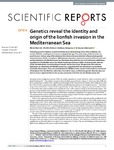Genetics reveal the identity and origin of the lionfish invasion in the Mediterranean Sea
| dc.contributor.author | Bariche, M | |
| dc.contributor.author | Kleitou, Periklis | |
| dc.contributor.author | Kalogirou, S | |
| dc.contributor.author | Bernardi, G | |
| dc.date.accessioned | 2018-05-10T14:38:25Z | |
| dc.date.issued | 2017-12 | |
| dc.identifier.issn | 2045-2322 | |
| dc.identifier.issn | 2045-2322 | |
| dc.identifier.other | 6782 | |
| dc.identifier.uri | http://hdl.handle.net/10026.1/11492 | |
| dc.description.abstract |
Following aquarium releases, invasive lionfishes have colonized large areas of the Caribbean and western Atlantic, resulting in an immense ecological damage. The early stages of that invasion are poorly known. Indeed, a lag of time between the introduction and detection often preclude genetic characterization of that crucial phase. With elevated awareness, the recent invasion of Pterois miles was quickly detected in the Mediterranean Sea. We hereby show that the very first individuals establishing populations in the Mediterranean Sea display haplotypes that nest within the large genetic diversity of Red Sea individuals, thus indicating an invasion via the Suez Canal. We also show that only two haplotypes are detected in the Mediterranean Sea, suggesting that few individuals may have been involved in the invasion. Thus, we conclude that the Mediterranean invasion is the result of a movement of individuals from the Red Sea, rather than from other means, and that low genetic diversity does not seem to have a negative effect on the success and spread of lionfish into the Mediterranean Sea. | |
| dc.format.extent | 6782- | |
| dc.format.medium | Electronic | |
| dc.language | en | |
| dc.language.iso | en | |
| dc.publisher | Springer Science and Business Media LLC | |
| dc.subject | Animals | |
| dc.subject | Fishes | |
| dc.subject | Haplotypes | |
| dc.subject | Introduced Species | |
| dc.subject | Mediterranean Sea | |
| dc.subject | Polymorphism, Genetic | |
| dc.title | Genetics reveal the identity and origin of the lionfish invasion in the Mediterranean Sea | |
| dc.type | journal-article | |
| dc.type | Article | |
| plymouth.author-url | https://www.webofscience.com/api/gateway?GWVersion=2&SrcApp=PARTNER_APP&SrcAuth=LinksAMR&KeyUT=WOS:000406610000033&DestLinkType=FullRecord&DestApp=ALL_WOS&UsrCustomerID=11bb513d99f797142bcfeffcc58ea008 | |
| plymouth.issue | 1 | |
| plymouth.volume | 7 | |
| plymouth.publication-status | Published online | |
| plymouth.journal | Scientific Reports | |
| dc.identifier.doi | 10.1038/s41598-017-07326-1 | |
| plymouth.organisational-group | /Plymouth | |
| plymouth.organisational-group | /Plymouth/Faculty of Science and Engineering | |
| plymouth.organisational-group | /Plymouth/Faculty of Science and Engineering/School of Biological and Marine Sciences | |
| plymouth.organisational-group | /Plymouth/Users by role | |
| plymouth.organisational-group | /Plymouth/Users by role/Academics | |
| dc.publisher.place | England | |
| dcterms.dateAccepted | 2017-06-21 | |
| dc.rights.embargodate | 2018-6-15 | |
| dc.identifier.eissn | 2045-2322 | |
| dc.rights.embargoperiod | No embargo | |
| rioxxterms.versionofrecord | 10.1038/s41598-017-07326-1 | |
| rioxxterms.licenseref.uri | http://www.rioxx.net/licenses/all-rights-reserved | |
| rioxxterms.licenseref.startdate | 2017-12 | |
| rioxxterms.type | Journal Article/Review |


